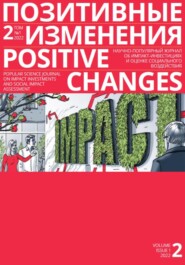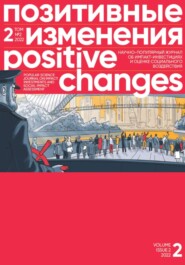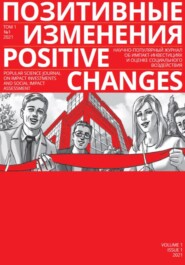По всем вопросам обращайтесь на: info@litportal.ru
(©) 2003-2025.
✖
Позитивные изменения. Города будущего. Тематический выпуск, 2022 / Positive changes. The cities of the future. Special issue, 2022
Настройки чтения
Размер шрифта
Высота строк
Поля
Бьярке Ингельс, датский архитектор, основатель и креативный партнер Bjarke Ingels Group:
«Сталкиваясь с пережитками прошлого, мы, архитекторы, можем – и должны – сделать так, чтобы не жителям города приходилось приспосабливаться к архаизмам, а сам город подстраивался под наши представления об идеальном образе жизни».
Источник цитаты: M0ller, A. Yes Is More: The BIG Philosophy. Retrieved from: https://www.archdaily.com/366660/yes-is-more-the-big-philosophy. 06 May2013. ArchDaily. (accessed 08.11.2022).
По оценке ООН, 15 ноября 2022 года численность населения Земли достигла 8 млрд человек. Отметки 8,5 млрд человечество, согласно прогнозам, достигнет к 2030 году, а пика – 10,4 млрд – к 2080 году.
Ма Яньсун, основатель самого известного архитектурного бюро Китая MAD Architects, профессор Пекинского университета гражданского строительства и архитектуры:
«Мне не нравится, во что превратились наши города из-за нашей долгой приверженности модернизму. Все стало однообразным и бездушным. Функциональность взяла верх над природой и эмоциями. Моя архитектура – это заявление о себе. Мы не проектируем здание как объект – мы стремимся создать ландшафт внутри городской среды. Меня вдохновляет традиционная архитектура Китая, где природа является неотъемлемой частью повседневной городской жизни. Я хочу взять китайские традиции комбинирования природы и архитектуры и адаптировать их к современной городской архитектуре».
Источник цитаты: Belogolovsky, V. Ma Yansong: «Some People May Say My Work Is Futuristic, But I See It as Traditional.» Retrieved from: https://www.archdaily.com/891656/ma-yansong-some-people-may-say-my-work-is-futuristic-but-i-see-it-as-traditional. 30 March 2018. ArchDaily. (accessed 08.11.2022).
Еще одна широко обсуждаемая концепция города будущего – «15-минутный город». По каким принципам должен строиться такой город?
Карлос Морено, франко-колумбийский урбанист, научный руководитель в Университете Пантеон-Сорбонна, популяризатор концепции «15-минутный город»:
«Необходимо переосмыслить концепцию городов исходя из четырех основополагающих принципов «15-минутного города». Во-первых, экология: город должен быть «зеленым» и экологичным. Во-вторых, близость: минимальное расстояние между жильем и социальной инфраструктурой. В-третьих, солидарность: создание связей между людьми. И в-четвертых, соучастие: жители должны активно вовлекаться в преобразование своего района. <…> Прежде всего, город должен жить в ритме людей, а не автомобилей. Далее, каждый квадратный метр пространства должен служить разным целям. И наконец, кварталы должны быть спроектированы так, чтобы в них можно было жить, работать и отдыхать без необходимости постоянно куда-то ездить».
Источник цитаты: Moreno, C. The 15-minute city. Retrieved from: https://www.ted.com/taiks/carios_moreno_the_15_minute_city/transcript. ED. (accessed 27.10.2022).
Департамент ООН по экономическим и социальным вопросам прогнозирует: к 2050 году 68 % населения мира будет жить в городах. Сейчас этот показатель составляет 55 % и в мире насчитывается около 4,2 млрд городских жителей.
Нужно ли архитекторам изучать прошлое в поисках будущего?
Норман Фостер, британский архитектор и дизайнер, лауреат Притцкеровской премии:
«Архитектура – это выражение ценностей. Возводимые нами здания отражают наш образ жизни. Вот почему такой оживленный интерес вызывают местные традиции и исторические наслоения городской застройки – ведь каждая эпоха оставляет в ней свой язык. Иногда полезно изучать прошлое в поисках будущего вдохновения. Архитектура является самым благородным воплощением ценностей нашего общества. <…> Наша работа может послужить ориентиром из прошлого для будущих поколений – нам еще предстоит увидеть полное осознание влияния экологических вопросов на архитектуру».
Источник цитаты: Rosenfield, K. Norman Foster's interview with The European: "Architecture is the Expression of Values." Retrieved from: https://www.archdaiiy. 31 October 2014. ArchDaiiy. (accessed 08.11.2022)..com/563537/int.erview-norman-fost.er-on-the-roie-of-architecture-in-modern-society
Ма Яньсун, основатель самого известного архитектурного бюро Китая MAD Architects, профессор Пекинского университета гражданского строительства и архитектуры:
«Архитектура для меня – это разговор, в котором я обращаюсь к прошлому и проецирую свои идеи в будущее. Архитектура – это искусство, характер и эмоции. Все они должны быть взаимосвязаны».
Источник цитаты: Belogolovsky, V. Ma Yansong: "Some People May Say My Work Is Futuristic, But I See It as Traditional." Retrieved from: https://www.archdaily.com/891656/ma-yansong-some-people-may-say-my-work-is-fujturistic-but-i-see-it-as-traditional. 30 March 2018. ArchDaily. (accessed 08.11.2022).
Можно ли говорить о каком-то универсальном подходе к проектированию города?
Норман Фостер, британский архитектор и дизайнер, лауреат Притцкеровской премии:
«Для каждого города должна быть своя, уникальная модель – не бывает универсального подхода к городской застройке. Однако, существуют и общие проблемы, и тут городам есть чему поучиться друг у друга. Например, плотность – один из важнейших критериев снижения энергопотребления и создания удобного, приятного для прогулок города».
Источник цитаты: Rosenfield, K. Norman Foster's Interview with The European: "Architecture is the Expression of Values." Retrieved from: https://www.archdaily.com/563537/interview-norman-foster-on-the-role-of-architecture-in-modern-society. 31 October 2014. ArchDaily. (accessed 08.11.2022).
Будет ли город будущего, экогород способствовать проявлению гражданской активности? Что для этого необходимо?
Норман Фостер, британский архитектор и дизайнер, лауреат Притцкеровской премии:
«Надо смотреть на поселения как на комбинацию инфраструктуры – маршруты, общественные пространства, коммуникации, транспорт – потому что экологичный город сегодня и в будущем – это прежде всего сильное гражданское общество. Речь идет о пешеходном движении: люди важнее машин. Речь идет о плотности. Города с высокой плотностью населения потребляют меньше энергии и являются более дружелюбными. Речь также идет о смешанном использовании: традиционный город никогда не разделялся на спальные районы, рабочие районы, культурные районы. Все это сочеталось вместе в одно прекрасное целое. Сегодня мы должны заново открыть для себя эту красоту».
Источник цитаты: Lord Norman Foster on the future of cities. Retrieved from: https://www.architecture.com/knowledge-and-resources/knowledge-landing-page/lord-norman-foster-on-the-future-of-cities. 29 June 2017. RIBA. (accessed 27.10.2022).
One Hundred Years Ahead: Architects on the Future of the Cities
We don't know what lies ahead, but we believe in a better future. Those who are already implementing innovative architectural solutions today are the ones who find it the easiest to look into the future in search of answers to the question "What conditions will the humankind live in?" The Positive Changes Journal editors have compiled the opinions of the leaders and founders of world-renowned architectural firms whose projects are already changing the face of the cities of today. The architects expound on how to combine the environment and urbanism, conserve the planet's resources and make the city adjust to the concept of an ideal way of life.
Yulia Vyatkina
Editor, Positive Changes Journal
Whenever somebody talks about cities of the future, they say those will be eco-cities. What is an eco-city as you understand it?
Balkrishna Doshi, Indian architect, founder of Vastu Shilpa Consultants, Pritzker Prize winner, worked under Le Corbusier:
"A truly sustainable city is a city where the least human energy and time is spent in getting things done. Then people have time for reflection and can once again act like human beings, not the robots they have been forced to become."
Cite: Singh-Bartlett, W. Pritzker Prize winner Balkrishna Doshi on modernism, India and dropping your ego. Retrieved from: https:// www.wallpaper.com/architecture/pritzker-prize-winner-balkrishna-doshi. 07 March 2018. Wallpaper. (accessed 08.11.2022).
What is the concept of "non-extractive architecture"? Is it possible to respect nature in architecture?
Joseph Grima, co-founder of the Italian design studio Space Caviar and architect, creative director of Design Academy Eindhoven and art critic:
"The architecture of the future must prioritise conserving the earth’s resources if humans are to overcome the evolutionary crisis that they currently face. Getting better at getting better will not on its own be sufficient. In the face of our accelerating technological supremacy, we can no longer afford to simply ask how much it is possible to extract from our habitat; we are now compelled to ask how much it is reasonable to extract. <…> Non-extractive architecture must fully consider the costs not just for the individual and for society, but also future societies who will live with the consequences of the choices of today’s technologically empowered humans."
Cite: Grima, J. (2021). Joseph Grima calls for "new form of architectural practice that considers the full chain of building's consequences." Retrieved from: https://www.dezeen.com/2021/11/17/joseph-grima-manifesto-dezeen-15/. 17 November 2021. Dezeen. (accessed 08.11.2022).
Will we get a healthy city by addressing environmental problems?
Ma Yansong, founder of China's most famous architectural firm, MAD Architects, a professor at Beijing University of Civil Engineering and Architecture:
"Modern cities right now are too much about efficiency and capital power. It is just about environment, pollution, traffic. Every city has to deal with them, but it doesn’t mean that if you solve them you have a "good city". You and I have a healthy body, but it doesn’t mean that we are mentally healthy… We talk about environment, energy saving and sustainability but I think it’s too much about technology. You have better air conditioning, better glass, better solar panels, but it doesn’t mean those who are working in this building want to stay there forever! They still want to escape every weekend and still go to the countryside because they still feel they aren’t connected with nature. That is the basics, the fundamental reason why we are starting to talk about nature now. If we say we want to be close to nature, why can’t we let the temperature be one degree less or more in your room, in the office?"
Cite: Rizzardi, P. & Hankun, Z. (TCA Think Tank). An Interview with MAD Architects' Ma Yansong: Constructing Icons, Identity & China's Future Cities. Retrieved from: https://www.archdaily. com/490712/an-int.erview-wit.h-mad-architects-ma-yansong-constructing-icons-identity-and-china-s-future-cities. 03 April 2014. ArchDaily. (accessed 08.11.2022).
Can environmental sustainability be achieved without sacrificing living standards?
Bjarke Ingels, Danish architect, founder and creative partner of Bjarke Ingels Group (BIG):
"It has been proven that, beyond a doubt, we have the capacity as the human race to cause massive impact at a planetary scale. That also means that with great power comes great responsibility… Now we have to find smart ways of making our cities resilient. Hedonistic sustainability is the idea that you can actually be sustainable but increase the quality of life while doing so. The same goes with resilience. You have to find smart ways of providing all these necessary safety measures, but do it in a way that advances the human project and creates a wonderful framework for human life."
Cite: Chu, J. Bjarke Ingels On The Future Of Architecture. Retrieved from: https://www.fastcompany.com/3041276/bjarke-ingels-on-the-future-of-architecture. 23 January 2015. Fast Company. (accessed 08.11.2022).
What is the role of the city's architects and planners? What should they consider?
Joseph Grima, co-founder of the Italian design studio Space Caviar and architect, creative director of Design Academy Eindhoven and art critic:
"Designers have a decisive role to play in envisioning the possibilities of future habitats, and they could start by conceiving alternatives to the radically decentralised geographies of contemporary material production and consumption."









